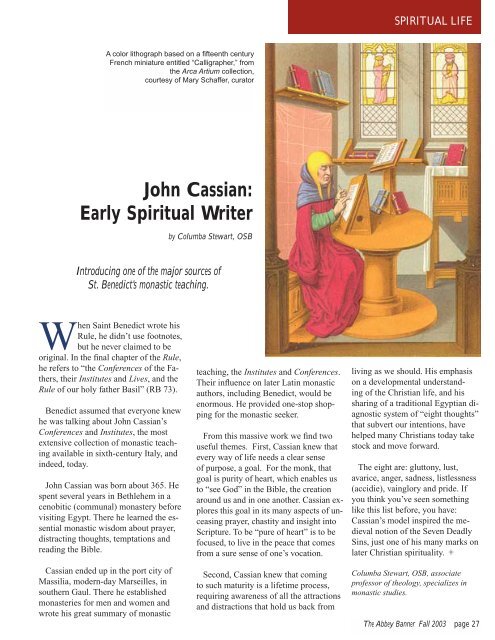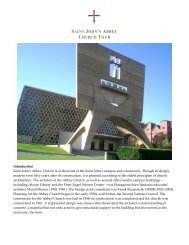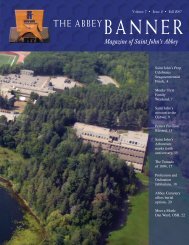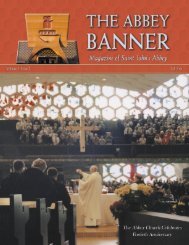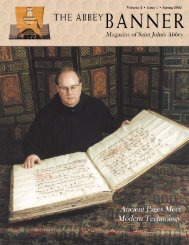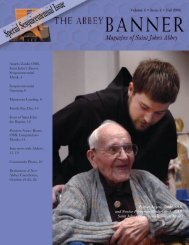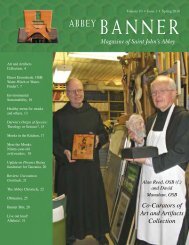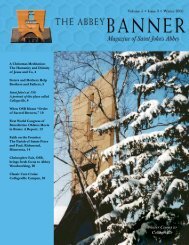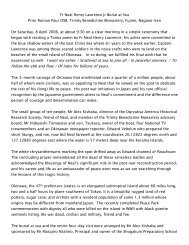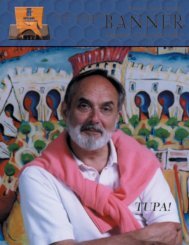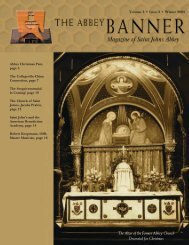Monks and Students Meet the Monks - St. John's Abbey
Monks and Students Meet the Monks - St. John's Abbey
Monks and Students Meet the Monks - St. John's Abbey
Create successful ePaper yourself
Turn your PDF publications into a flip-book with our unique Google optimized e-Paper software.
When Saint Benedict wrote his<br />
Rule, he didn’t use footnotes,<br />
but he never claimed to be<br />
original. In <strong>the</strong> fi nal chapter of <strong>the</strong> Rule,<br />
he refers to “<strong>the</strong> Conferences of <strong>the</strong> Fa<strong>the</strong>rs,<br />
<strong>the</strong>ir Institutes <strong>and</strong> Lives, <strong>and</strong> <strong>the</strong><br />
Rule of our holy fa<strong>the</strong>r Basil” (RB 73).<br />
Benedict assumed that everyone knew<br />
he was talking about John Cassian’s<br />
Conferences <strong>and</strong> Institutes, <strong>the</strong> most<br />
extensive collection of monastic teaching<br />
available in sixth-century Italy, <strong>and</strong><br />
indeed, today.<br />
John Cassian was born about 365. He<br />
spent several years in Bethlehem in a<br />
cenobitic (communal) monastery before<br />
visiting Egypt. There he learned <strong>the</strong> essential<br />
monastic wisdom about prayer,<br />
distracting thoughts, temptations <strong>and</strong><br />
reading <strong>the</strong> Bible.<br />
Cassian ended up in <strong>the</strong> port city of<br />
Massilia, modern-day Marseilles, in<br />
sou<strong>the</strong>rn Gaul. There he established<br />
monasteries for men <strong>and</strong> women <strong>and</strong><br />
wrote his great summary of monastic<br />
A color lithograph based on a fi fteenth century<br />
French miniature entitled “Calligrapher,” from<br />
<strong>the</strong> Arca Artium collection,<br />
courtesy of Mary Schaffer, curator<br />
John Cassian:<br />
Early Spiritual Writer<br />
by Columba <strong>St</strong>ewart, OSB<br />
Introducing one of <strong>the</strong> major sources of<br />
<strong>St</strong>. Benedict’s monastic teaching.<br />
teaching, <strong>the</strong> Institutes <strong>and</strong> Conferences.<br />
Their infl uence on later Latin monastic<br />
authors, including Benedict, would be<br />
enormous. He provided one-stop shopping<br />
for <strong>the</strong> monastic seeker.<br />
From this massive work we fi nd two<br />
useful <strong>the</strong>mes. First, Cassian knew that<br />
every way of life needs a clear sense<br />
of purpose, a goal. For <strong>the</strong> monk, that<br />
goal is purity of heart, which enables us<br />
to “see God” in <strong>the</strong> Bible, <strong>the</strong> creation<br />
around us <strong>and</strong> in one ano<strong>the</strong>r. Cassian explores<br />
this goal in its many aspects of unceasing<br />
prayer, chastity <strong>and</strong> insight into<br />
Scripture. To be “pure of heart” is to be<br />
focused, to live in <strong>the</strong> peace that comes<br />
from a sure sense of one’s vocation.<br />
Second, Cassian knew that coming<br />
to such maturity is a lifetime process,<br />
requiring awareness of all <strong>the</strong> attractions<br />
<strong>and</strong> distractions that hold us back from<br />
SPIRITUAL LIFE<br />
living as we should. His emphasis<br />
on a developmental underst<strong>and</strong>ing<br />
of <strong>the</strong> Christian life, <strong>and</strong> his<br />
sharing of a traditional Egyptian diagnostic<br />
system of “eight thoughts”<br />
that subvert our intentions, have<br />
helped many Christians today take<br />
stock <strong>and</strong> move forward.<br />
The eight are: gluttony, lust,<br />
avarice, anger, sadness, listlessness<br />
(accidie), vainglory <strong>and</strong> pride. If<br />
you think you’ve seen something<br />
like this list before, you have:<br />
Cassian’s model inspired <strong>the</strong> medieval<br />
notion of <strong>the</strong> Seven Deadly<br />
Sins, just one of his many marks on<br />
later Christian spirituality.<br />
Columba <strong>St</strong>ewart, OSB, associate<br />
professor of <strong>the</strong>ology, specializes in<br />
monastic studies.<br />
The <strong>Abbey</strong> Banner Fall 2003 page 27


